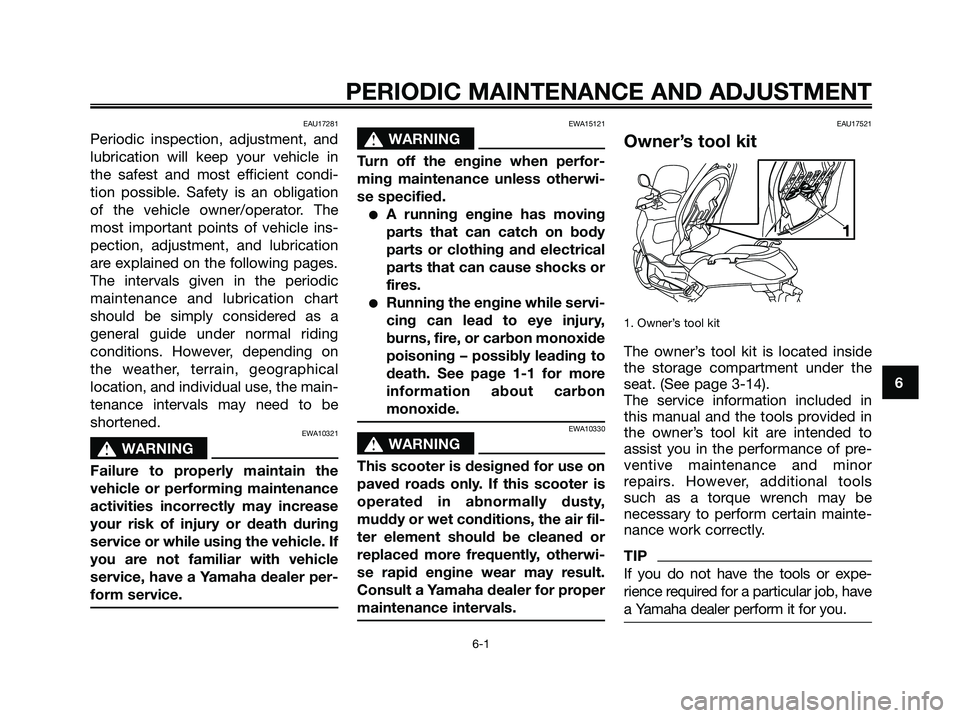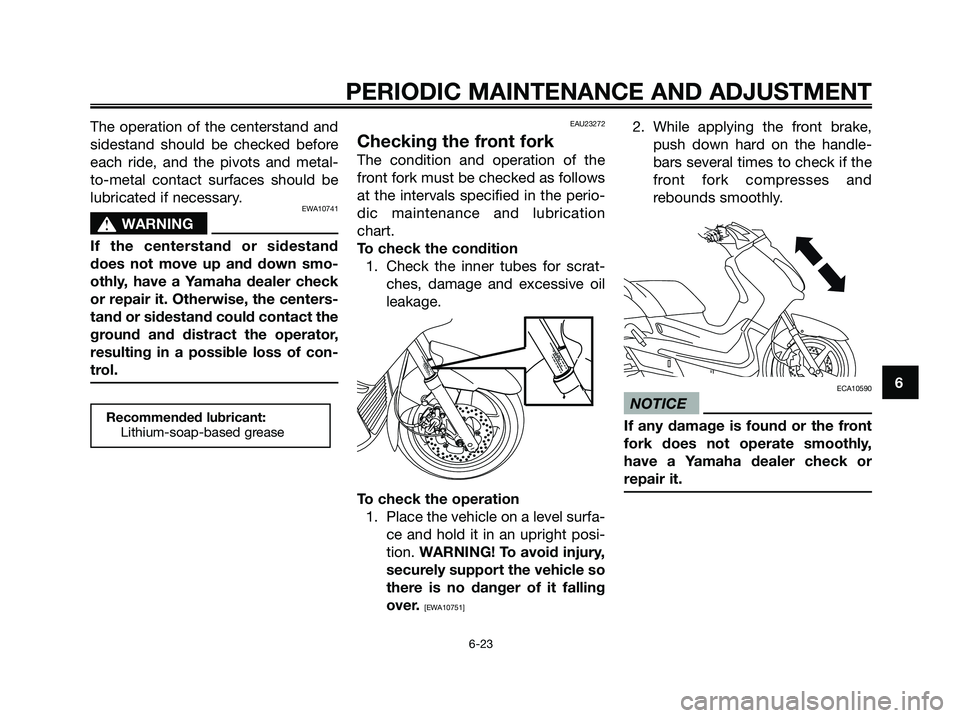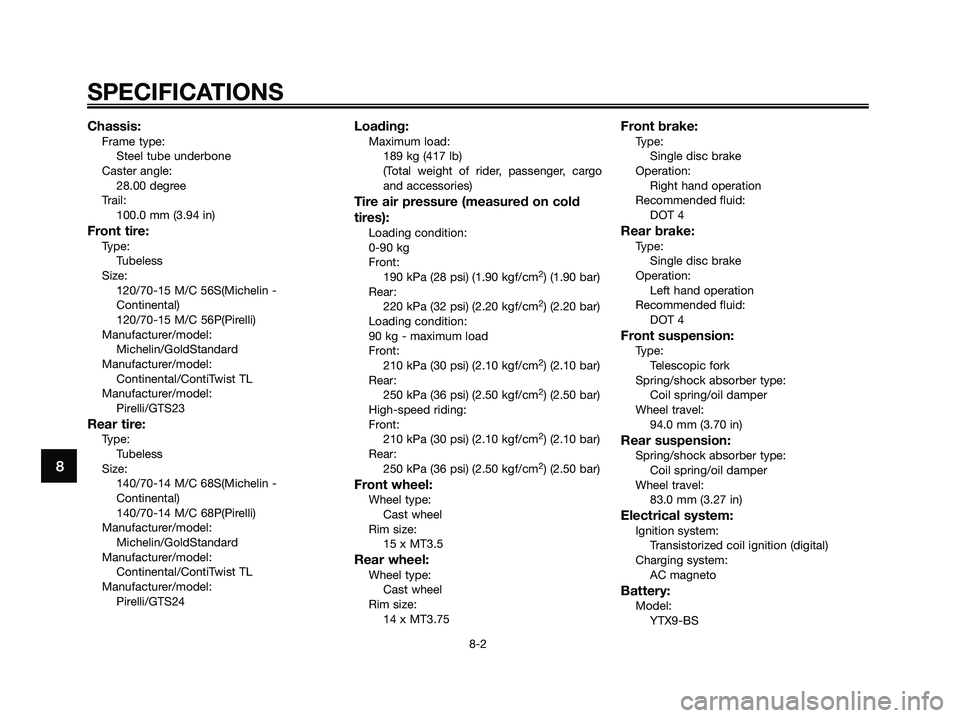2009 YAMAHA XMAX 125 air condition
[x] Cancel search: air conditionPage 9 of 92

• Always obey the speed limit
and never travel faster than
warranted by road and traffic
conditions.
• Always signal before turning or
changing lanes. Make sure that
other motorists can see you.
●The posture of the operator and
passenger is important for proper
control.
• The operator should keep both
hands on the handlebar and
both feet on the operator foo-
trests during operation to
maintain control of the scooter.
• The passenger should always
hold onto the operator, the seat
strap or grab bar, if equipped,
with both hands and keep both
feet on the passenger foo-
trests. Never carry a passenger
unless he or she can firmly pla-
ce both feet on the passenger
footrests.
●Never ride under the influence of
alcohol or other drugs.
●This scooter is designed for on-
road use only. It is not suitable for
off-road use.
Protective apparel
The majority of fatalities from scooter
accidents are the result of head inju-
ries. The use of a safety helmet is the
single most critical factor in the pre-
vention or reduction of head injuries.
●Always wear an approved hel-
met.
●Wear a face shield or goggles.
Wind in your unprotected eyes
could contribute to an impair-
ment of vision that could delay
seeing a hazard.
●The use of a jacket, substantial
shoes, trousers, gloves, etc., is
effective in preventing or redu-
cing abrasions or lacerations.
●Never wear loose-fitting clothes,
otherwise they could catch on
the control levers or wheels and
cause injury or an accident.
●Always wear protective clothing
that covers your legs, ankles, and
feet. The engine or exhaust sys-
tem become very hot during orafter operation and can cause
burns.
●A passenger should also observe
the above precautions.
Avoid Carbon Monoxide Poisoning
All engine exhaust contains carbon
monoxide, a deadly gas. Breathing
carbon monoxide can cause heada-
ches, dizziness, drowsiness, nausea,
confusion, and eventually death.
Carbon Monoxide is a colorless,
odorless, tasteless gas which may be
present even if you do not see or
smell any engine exhaust. Deadly
levels of carbon monoxide can collect
rapidly and you can quickly be over-
come and unable to save yourself.
Also, deadly levels of carbon monoxi-
de can linger for hours or days in
enclosed or poorly ventilated areas. If
you experience any symptoms of car-
bon monoxide poisoning, leave the
area immediately, get fresh air, and
SEEK MEDICAL TREATMENT.
●Do not run engine indoors. Even
if you try to ventilate engine
exhaust with fans or open win-
1
SAFETY INFORMATION
1-2
1B9-F8199-E3.QXD 21/10/08 13:42 Página 9
Page 37 of 92

FOR YOUR SAFETY – PRE-OPERATION CHECKS
4-2
4
ITEM CHECKS PAGE
• Check operation.
• If soft or spongy, have Yamaha dealer bleed hydraulic system.
• Check brake pads for wear.
Rear brake• Replace if necessary. 6-19, 6-20
• Check fluid level in reservoir.
• If necessary, add recommended brake fluid to specified level.
• Check hydraulic system for leakage.
• Make sure that operation is smooth.
Throttle grip• Check cable free play.
6-22
• If necessary, have Yamaha dealer adjust cable free play and lubricate cable
and grip housing.
• Check for damage.
Wheels and tires• Check tire condition and tread depth.
6-16, 6-18
• Check air pressure.
• Correct if necessary.
Brake levers• Make sure that operation is smooth.
• Lubricate lever pivoting points if necessary.6-22
Centerstand, sidestand• Make sure that operation is smooth.
• Lubricate pivots if necessary.6-22
Chassis fasteners• Make sure that all nuts, bolts and screws are properly tightened.
• Tighten if necessary.—
Instruments, lights, signals • Check operation.
and switches• Correct if necessary.—
Sidestand switch • Check operation of ignition circuit cut-off system.
• If system is not working correctly, have Yamaha dealer check vehicle.3-18
1B9-F8199-E3.QXD 21/10/08 13:42 Página 37
Page 43 of 92

EAU17281
Periodic inspection, adjustment, and
lubrication will keep your vehicle in
the safest and most efficient condi-
tion possible. Safety is an obligation
of the vehicle owner/operator. The
most important points of vehicle ins-
pection, adjustment, and lubrication
are explained on the following pages.
The intervals given in the periodic
maintenance and lubrication chart
should be simply considered as a
general guide under normal riding
conditions. However, depending on
the weather, terrain, geographical
location, and individual use, the main-
tenance intervals may need to be
shortened.
EWA10321
s s
WARNING
Failure to properly maintain the
vehicle or performing maintenance
activities incorrectly may increase
your risk of injury or death during
service or while using the vehicle. If
you are not familiar with vehicle
service, have a Yamaha dealer per-
form service.
EWA15121
s s
WARNING
Turn off the engine when perfor-
ming maintenance unless otherwi-
se specified.
●A running engine has moving
parts that can catch on body
parts or clothing and electrical
parts that can cause shocks or
fires.
●Running the engine while servi-
cing can lead to eye injury,
burns, fire, or carbon monoxide
poisoning – possibly leading to
death. See page 1-1 for more
information about carbon
monoxide.
EWA10330
s s
WARNING
This scooter is designed for use on
paved roads only. If this scooter is
operated in abnormally dusty,
muddy or wet conditions, the air fil-
ter element should be cleaned or
replaced more frequently, otherwi-
se rapid engine wear may result.
Consult a Yamaha dealer for proper
maintenance intervals.
EAU17521
Owner’s tool kit
1. Owner’s tool kit
The owner’s tool kit is located inside
the storage compartment under the
seat. (See page 3-14).
The service information included in
this manual and the tools provided in
the owner’s tool kit are intended to
assist you in the performance of pre-
ventive maintenance and minor
repairs. However, additional tools
such as a torque wrench may be
necessary to perform certain mainte-
nance work correctly.
TIP
If you do not have the tools or expe-
rience required for a particular job, have
a Yamaha dealer perform it for you.
PERIODIC MAINTENANCE AND ADJUSTMENT
6-1
6
1B9-F8199-E3.QXD 21/10/08 13:42 Página 43
Page 59 of 92

●The tire air pressure must be
adjusted in accordance with
the riding speed and with the
total weight of rider, passenger,
cargo, and accessories appro-
ved for this model.EWA14660
s s
WARNING
Because loading has an enormous
impact on the handling, braking,
performance and safety characte-
ristics of your vehicle, you should
keep the following precautions in
mind.
●NEVER OVERLOAD THE VEHI-
CLE! Operation of an overloa-
ded vehicle may result in tire
damage, loss of control, or
severe injury. Make sure that
the total weight of rider, pas-
senger, cargo, and accessories
does not exceed the specified
maximum load for the vehicle.
●Do not carry along loosely pac-
ked items, which can shift
during a ride.
●Securely pack the heaviest
items close to the center of the
vehicle and distribute the
weight evenly on both sides.
●Adjust the suspension and tire air
pressure with regard to the load.
●Check the tire condition and air
pressure before each ride.
Tire inspection
1. Tire tread depth
2. Tire sidewall
The tires must be checked before
each ride. If the center tread depth
reaches the specified limit, if the tire
has a nail or glass fragments in it, or if
the sidewall is cracked, have a Yama-
ha dealer replace the tire immediately.
Minimum tire tread depth (front
and rear):
1.6 mm (0.06 in)
1
2
ZAUM0054
Tire air pressure (measured on
cold tires):
Up to 90 kg (198 lb):
Front:
190 kPa (27.02 psi) (1.9
kgf/cm
2)
Rear:
220 kPa (31.29 psi) (2.2
kgf/cm
2)
90 kg (198 lb) to maximum load:
Front:
210 kPa (29.86 psi) (2.1
kgf/cm
2)
Rear:
250 kPa (35.55 psi) (2.5
kgf/cm
2)
Maximum load*:
189 kg (417 lb)
* Total weight of rider, passenger,
cargo and accessories
PERIODIC MAINTENANCE AND ADJUSTMENT
6-17
6
1B9-F8199-E3.QXD 21/10/08 13:43 Página 59
Page 65 of 92

The operation of the centerstand and
sidestand should be checked before
each ride, and the pivots and metal-
to-metal contact surfaces should be
lubricated if necessary.
EWA10741
s s
WARNING
If the centerstand or sidestand
does not move up and down smo-
othly, have a Yamaha dealer check
or repair it. Otherwise, the centers-
tand or sidestand could contact the
ground and distract the operator,
resulting in a possible loss of con-
trol.
EAU23272
Checking the front fork
The condition and operation of the
front fork must be checked as follows
at the intervals specified in the perio-
dic maintenance and lubrication
chart.
To check the condition
1. Check the inner tubes for scrat-
ches, damage and excessive oil
leakage.
To check the operation
1. Place the vehicle on a level surfa-
ce and hold it in an upright posi-
tion. WARNING! To avoid injury,
securely support the vehicle so
there is no danger of it falling
over.
[EWA10751]
2. While applying the front brake,
push down hard on the handle-
bars several times to check if the
front fork compresses and
rebounds smoothly.
ECA10590
NOTICE
If any damage is found or the front
fork does not operate smoothly,
have a Yamaha dealer check or
repair it.Recommended lubricant:
Lithium-soap-based grease
PERIODIC MAINTENANCE AND ADJUSTMENT
6-23
6
1B9-F8199-E3.QXD 21/10/08 13:43 Página 65
Page 82 of 92

Chassis:Frame type:
Steel tube underbone
Caster angle:
28.00 degree
Trail:
100.0 mm (3.94 in)
Front tire:Type:
Tubeless
Size:
120/70-15 M/C 56S(Michelin -
Continental)
120/70-15 M/C 56P(Pirelli)
Manufacturer/model:
Michelin/GoldStandard
Manufacturer/model:
Continental/ContiTwist TL
Manufacturer/model:
Pirelli/GTS23
Rear tire:Type:
Tubeless
Size:
140/70-14 M/C 68S(Michelin -
Continental)
140/70-14 M/C 68P(Pirelli)
Manufacturer/model:
Michelin/GoldStandard
Manufacturer/model:
Continental/ContiTwist TL
Manufacturer/model:
Pirelli/GTS24
Loading:Maximum load:
189 kg (417 lb)
(Total weight of rider, passenger, cargo
and accessories)
Tire air pressure (measured on cold
tires):
Loading condition:
0-90 kg
Front:
190 kPa (28 psi) (1.90 kgf/cm
2) (1.90 bar)
Rear:
220 kPa (32 psi) (2.20 kgf/cm
2) (2.20 bar)
Loading condition:
90 kg - maximum load
Front:
210 kPa (30 psi) (2.10 kgf/cm
2) (2.10 bar)
Rear:
250 kPa (36 psi) (2.50 kgf/cm
2) (2.50 bar)
High-speed riding:
Front:
210 kPa (30 psi) (2.10 kgf/cm
2) (2.10 bar)
Rear:
250 kPa (36 psi) (2.50 kgf/cm
2) (2.50 bar)
Front wheel:Wheel type:
Cast wheel
Rim size:
15 x MT3.5
Rear wheel:Wheel type:
Cast wheel
Rim size:
14 x MT3.75
Front brake:Type:
Single disc brake
Operation:
Right hand operation
Recommended fluid:
DOT 4
Rear brake:Type:
Single disc brake
Operation:
Left hand operation
Recommended fluid:
DOT 4
Front suspension:Type:
Telescopic fork
Spring/shock absorber type:
Coil spring/oil damper
Wheel travel:
94.0 mm (3.70 in)
Rear suspension:Spring/shock absorber type:
Coil spring/oil damper
Wheel travel:
83.0 mm (3.27 in)
Electrical system:Ignition system:
Transistorized coil ignition (digital)
Charging system:
AC magneto
Battery:Model:
YTX9-BS
SPECIFICATIONS
8-2
8
1B9-F8199-E3.QXD 21/10/08 13:43 Página 82